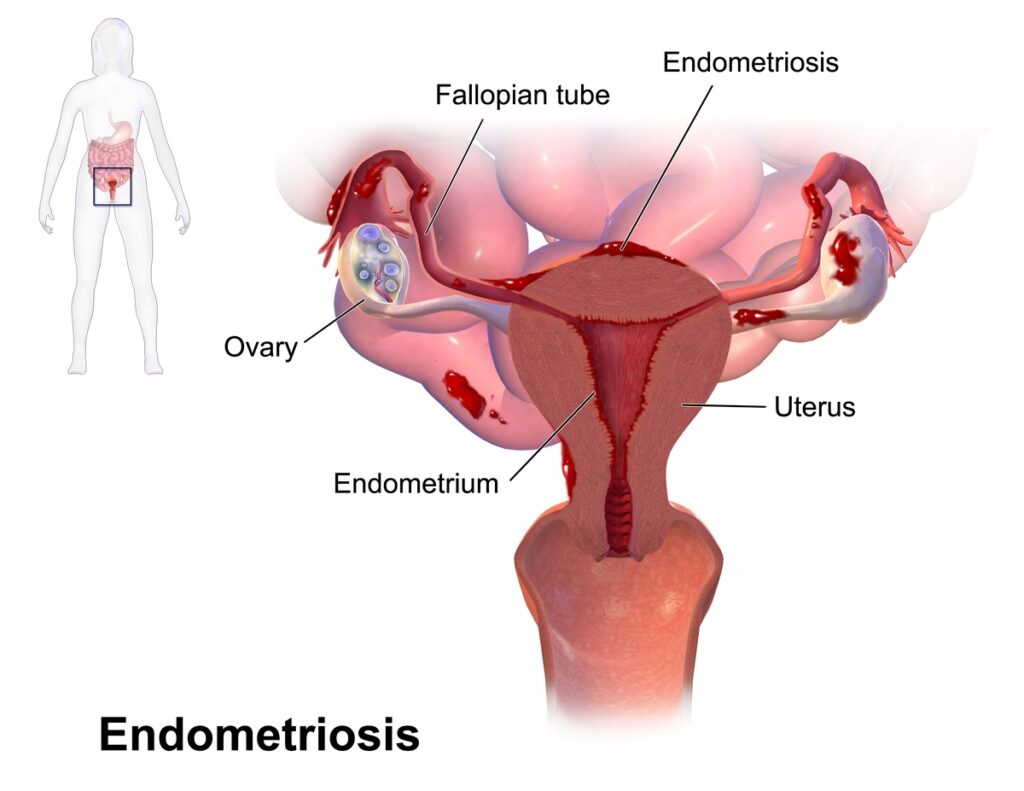
- Endometriosis is a complex and often painful medical condition in which tissue similar to the lining of the uterus (called the endometrium) grows outside the uterus. This tissue behaves like normal endometrial tissue — it thickens, breaks down, and bleeds with each menstrual cycle. However, because it has no way to exit the body, it becomes trapped, leading to inflammation, pain, and in some cases, the formation of scar tissue and adhesions.
Endometriosis is a complex and often painful medical condition in which tissue similar to the lining of the uterus (called the endometrium) grows outside the uterus. This tissue behaves like normal endometrial tissue — it thickens, breaks down, and bleeds with each menstrual cycle. However, because it has no way to exit the body, it becomes trapped, leading to inflammation, pain, and in some cases, the formation of scar tissue and adhesions.
1. What Is Endometriosis?
- Definition: Growth of endometrial-like tissue outside the uterus.
- Common Sites:
- Ovaries
- Fallopian tubes
- Outer surface of the uterus
- Pelvic lining
- Rarely, it can appear in other organs like the bladder, intestines, and even the lungs.
2. Symptoms of Endometriosis
Symptoms vary widely, and some women may have no symptoms at all. Common ones include:
- Pelvic pain, especially during menstruation (dysmenorrhea)
- Pain during intercourse (dyspareunia)
- Pain with bowel movements or urination, especially during menstrual periods
- Excessive bleeding during periods or between cycles
- Infertility
- Fatigue, diarrhea, constipation, bloating, or nausea, particularly during menstrual periods
3. Causes and Risk Factors
The exact cause is unknown, but several theories exist:
- Retrograde menstruation: Menstrual blood flows backward into the pelvic cavity instead of leaving the body.
- Genetic predisposition: It tends to run in families.
- Immune system disorders
- Hormonal imbalances
- Surgical scars: Endometrial cells may attach to incisions after surgeries like C-sections.
Risk factors:
- Never giving birth
- Early menstruation
- Late menopause
- Short menstrual cycles
- High estrogen levels
- Low body mass index
- Family history
4. Diagnosis
Diagnosis can be tricky due to the variability of symptoms and overlap with other conditions.
- Pelvic exam
- Ultrasound: May reveal cysts associated with endometriosis.
- MRI: For detailed imaging.
- Laparoscopy: A minimally invasive surgery that allows direct visualization and biopsy. It is the gold standard for diagnosis.
5. Stages of Endometriosis
The American Society for Reproductive Medicine classifies endometriosis into four stages:
- Minimal (Stage I)
- Mild (Stage II)
- Moderate (Stage III)
- Severe (Stage IV)
These are based on:
- Location
- Amount and depth of endometrial implants
- Presence and severity of scar tissue and ovarian cysts
6. Treatment Options
Treatment depends on severity, symptoms, and fertility goals.
Medications
- Pain relief: NSAIDs (e.g., ibuprofen)
- Hormone therapy:
- Birth control pills
- GnRH agonists/antagonists
- Progestins
- Aromatase inhibitors
Surgical Treatment
- Laparoscopic excision or ablation of endometrial implants
- Hysterectomy in severe cases (usually a last resort)
Fertility Treatment
- Assisted reproductive technologies like IVF if conception is difficult.
7. Living with Endometriosis
- Chronic condition: While there is no cure, symptoms can often be managed.
- Diet and lifestyle: Anti-inflammatory diets, regular exercise, acupuncture, and stress reduction can help.
- Support groups: Connecting with others can provide emotional support and coping strategies.
8. Complications
- Infertility
- Chronic pelvic pain
- Ovarian cysts (endometriomas)
- Bowel or bladder complications
Would you like a visual diagram or infographic to go along with this explanation? Or are you looking for more specific information like natural remedies, surgical options, or endometriosis and fertility?

